Research on Building Information Modelling and AI in Civil Engineering
VerifiedAdded on 2021/02/20
|43
|13270
|299
Report
AI Summary
This research paper critically analyzes the integration of Building Information Modeling (BIM) and Artificial Intelligence (AI) technologies in civil engineering, focusing on their applications in the construction sector. The study examines three case studies: airport infrastructure, cross-rail projects, and industrial building construction, highlighting the benefits and impacts of BIM and AI. The paper covers the application of BIM and AI, and their impacts, followed by discussions on the challenges in adopting BIM, including political, legal, technical, economic, and skill-related issues. The report provides a comprehensive review of the current trends and future prospects of BIM and AI technologies in civil engineering, supported by literature reviews and case studies. The research also includes an overview of the integration of the technologies into the construction sector and its role in improving design, construction, and information cycle flow in various stages.
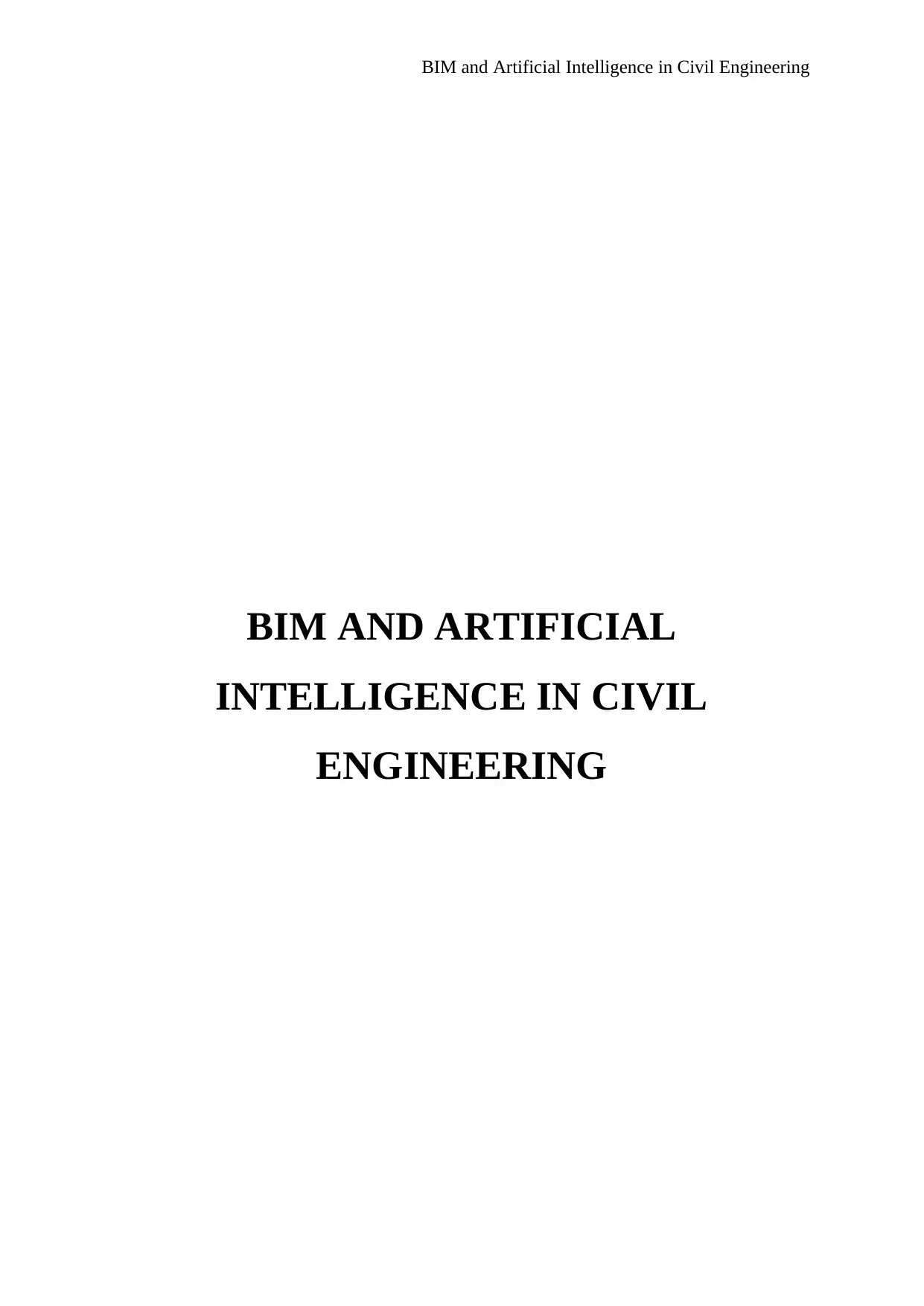
BIM and Artificial Intelligence in Civil Engineering
BIM AND ARTIFICIAL
INTELLIGENCE IN CIVIL
ENGINEERING
BIM AND ARTIFICIAL
INTELLIGENCE IN CIVIL
ENGINEERING
Paraphrase This Document
Need a fresh take? Get an instant paraphrase of this document with our AI Paraphraser
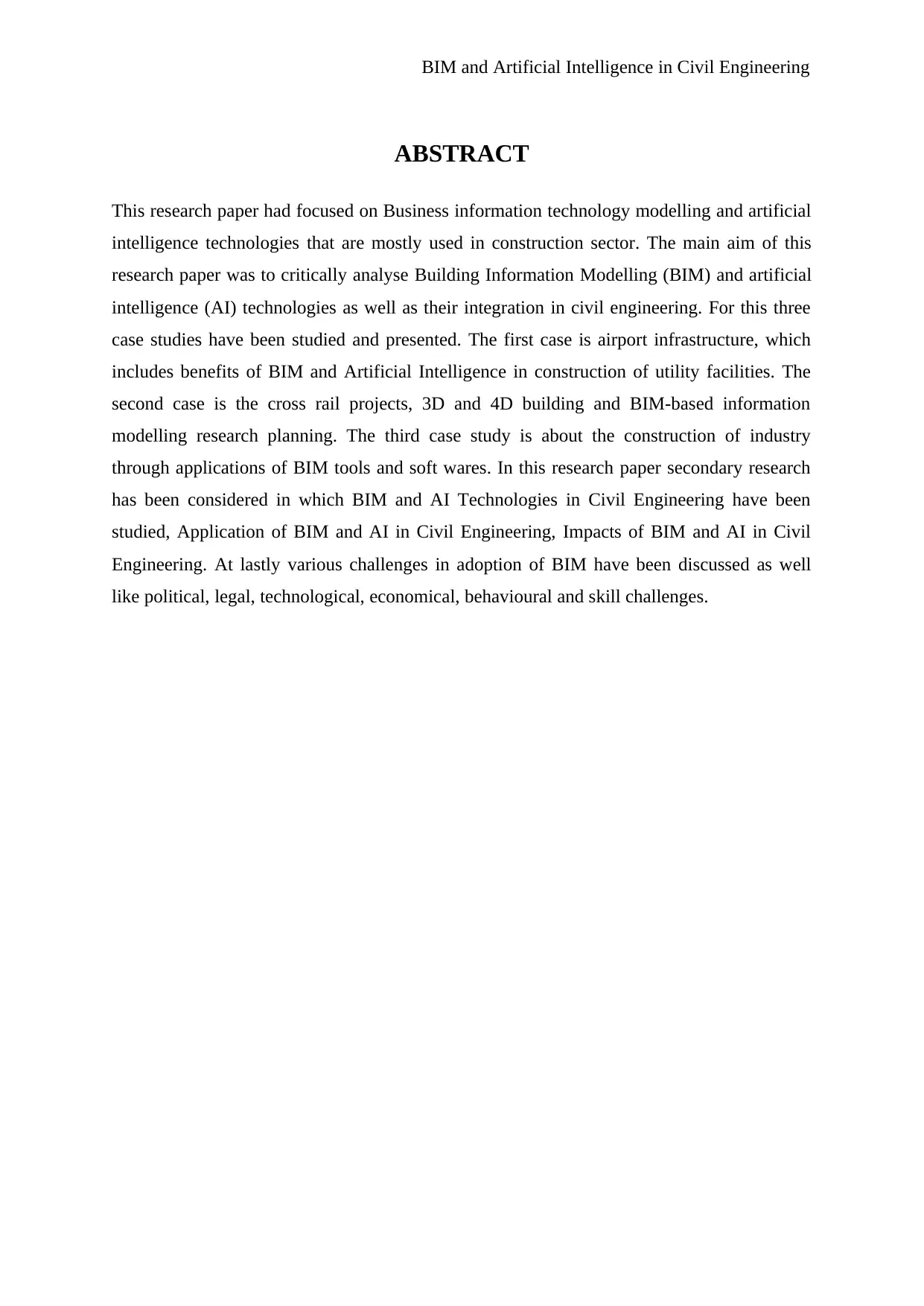
BIM and Artificial Intelligence in Civil Engineering
ABSTRACT
This research paper had focused on Business information technology modelling and artificial
intelligence technologies that are mostly used in construction sector. The main aim of this
research paper was to critically analyse Building Information Modelling (BIM) and artificial
intelligence (AI) technologies as well as their integration in civil engineering. For this three
case studies have been studied and presented. The first case is airport infrastructure, which
includes benefits of BIM and Artificial Intelligence in construction of utility facilities. The
second case is the cross rail projects, 3D and 4D building and BIM-based information
modelling research planning. The third case study is about the construction of industry
through applications of BIM tools and soft wares. In this research paper secondary research
has been considered in which BIM and AI Technologies in Civil Engineering have been
studied, Application of BIM and AI in Civil Engineering, Impacts of BIM and AI in Civil
Engineering. At lastly various challenges in adoption of BIM have been discussed as well
like political, legal, technological, economical, behavioural and skill challenges.
ABSTRACT
This research paper had focused on Business information technology modelling and artificial
intelligence technologies that are mostly used in construction sector. The main aim of this
research paper was to critically analyse Building Information Modelling (BIM) and artificial
intelligence (AI) technologies as well as their integration in civil engineering. For this three
case studies have been studied and presented. The first case is airport infrastructure, which
includes benefits of BIM and Artificial Intelligence in construction of utility facilities. The
second case is the cross rail projects, 3D and 4D building and BIM-based information
modelling research planning. The third case study is about the construction of industry
through applications of BIM tools and soft wares. In this research paper secondary research
has been considered in which BIM and AI Technologies in Civil Engineering have been
studied, Application of BIM and AI in Civil Engineering, Impacts of BIM and AI in Civil
Engineering. At lastly various challenges in adoption of BIM have been discussed as well
like political, legal, technological, economical, behavioural and skill challenges.
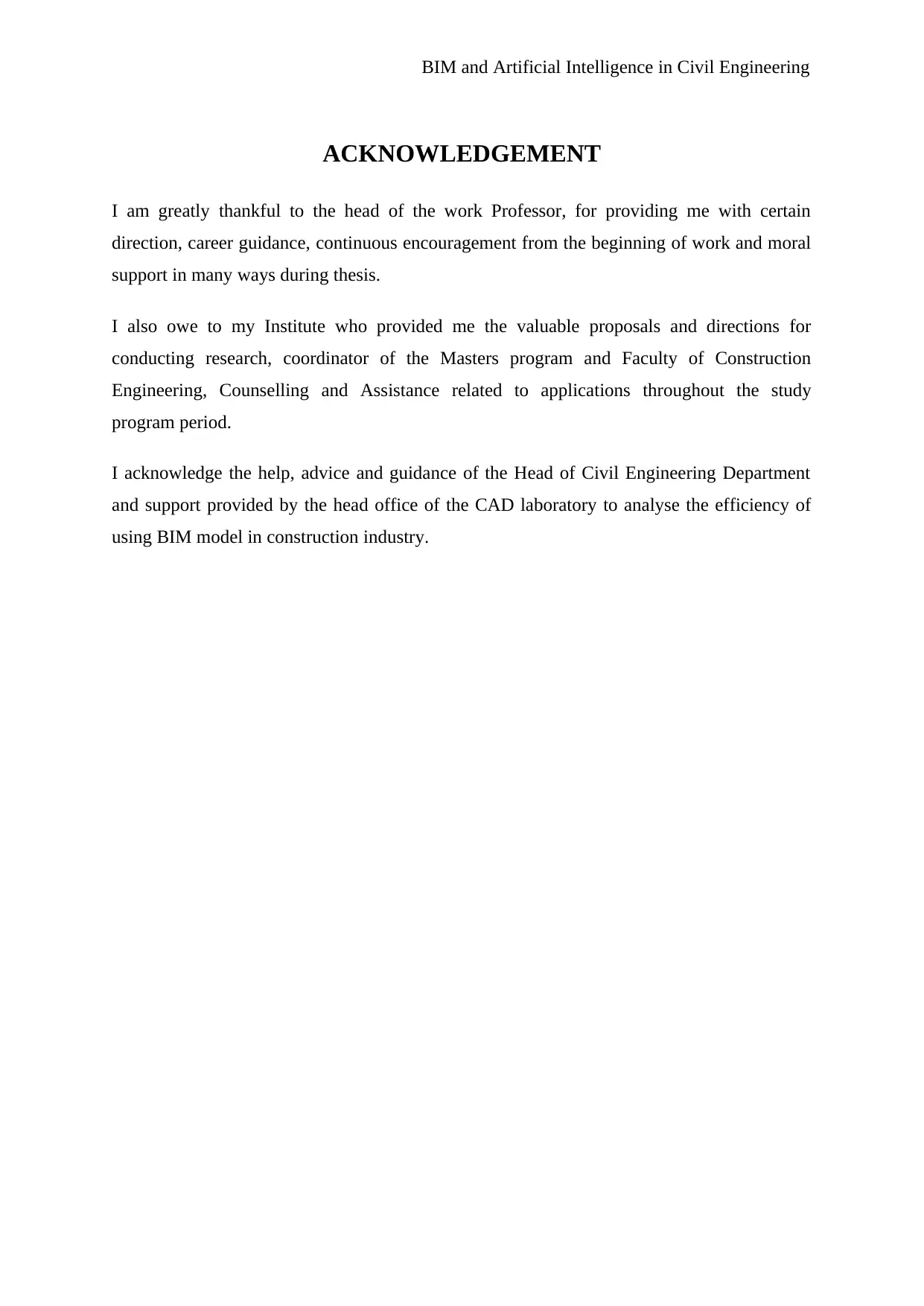
BIM and Artificial Intelligence in Civil Engineering
ACKNOWLEDGEMENT
I am greatly thankful to the head of the work Professor, for providing me with certain
direction, career guidance, continuous encouragement from the beginning of work and moral
support in many ways during thesis.
I also owe to my Institute who provided me the valuable proposals and directions for
conducting research, coordinator of the Masters program and Faculty of Construction
Engineering, Counselling and Assistance related to applications throughout the study
program period.
I acknowledge the help, advice and guidance of the Head of Civil Engineering Department
and support provided by the head office of the CAD laboratory to analyse the efficiency of
using BIM model in construction industry.
ACKNOWLEDGEMENT
I am greatly thankful to the head of the work Professor, for providing me with certain
direction, career guidance, continuous encouragement from the beginning of work and moral
support in many ways during thesis.
I also owe to my Institute who provided me the valuable proposals and directions for
conducting research, coordinator of the Masters program and Faculty of Construction
Engineering, Counselling and Assistance related to applications throughout the study
program period.
I acknowledge the help, advice and guidance of the Head of Civil Engineering Department
and support provided by the head office of the CAD laboratory to analyse the efficiency of
using BIM model in construction industry.
⊘ This is a preview!⊘
Do you want full access?
Subscribe today to unlock all pages.

Trusted by 1+ million students worldwide

BIM and Artificial Intelligence in Civil Engineering
DECLARATION
I certify that the data provided above is in accordance with my knowledge and trust is
accurate and correct and obliged to immediately notify you of any changes. In the case of one
of the above information has been determined is misinterpreted or misleading, I may be
responsible. I hereby authorize the distribution of information provided in this form to the
Civil Engineering Department is provided by me.
DECLARATION
I certify that the data provided above is in accordance with my knowledge and trust is
accurate and correct and obliged to immediately notify you of any changes. In the case of one
of the above information has been determined is misinterpreted or misleading, I may be
responsible. I hereby authorize the distribution of information provided in this form to the
Civil Engineering Department is provided by me.
Paraphrase This Document
Need a fresh take? Get an instant paraphrase of this document with our AI Paraphraser
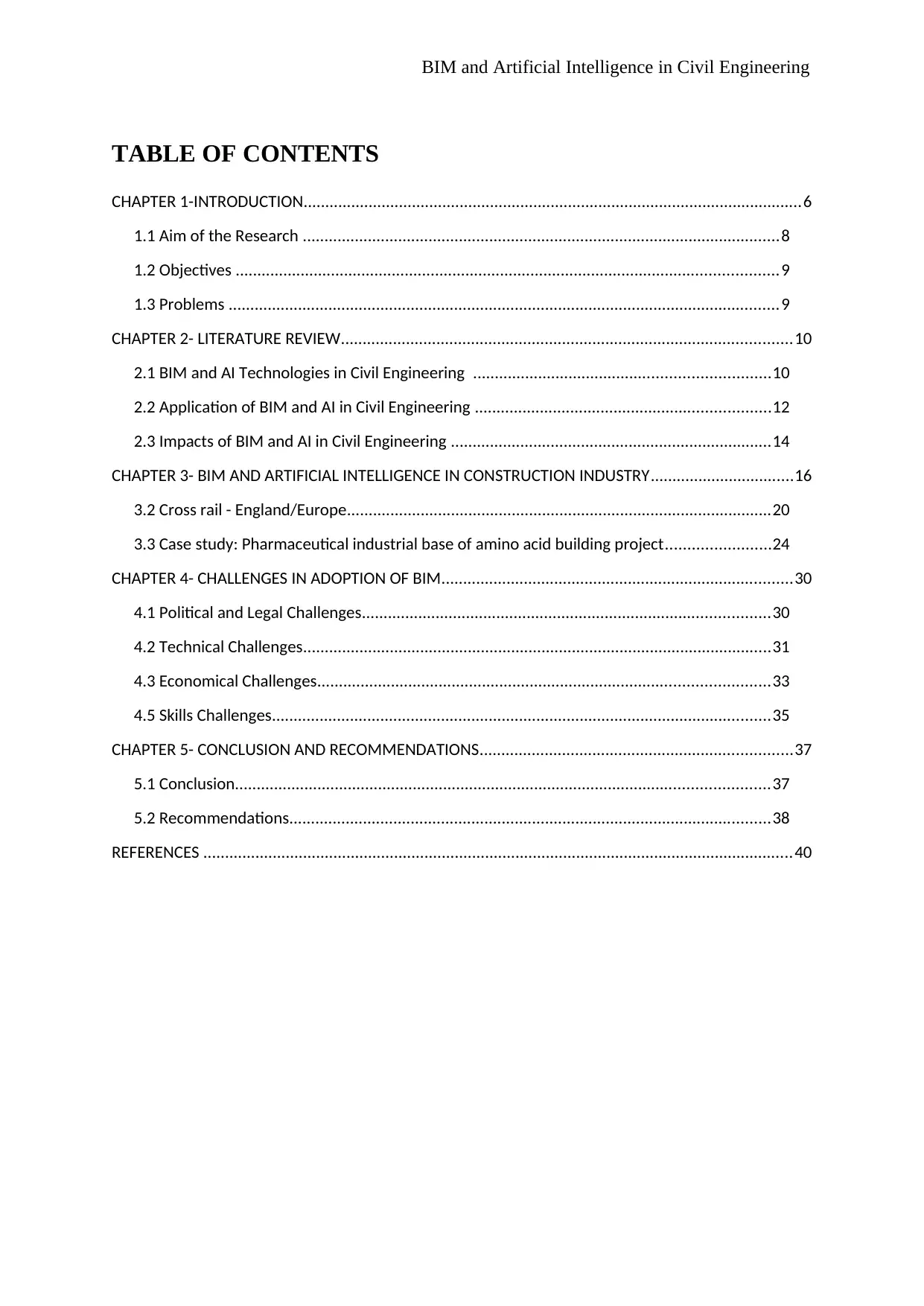
BIM and Artificial Intelligence in Civil Engineering
TABLE OF CONTENTS
CHAPTER 1-INTRODUCTION...................................................................................................................6
1.1 Aim of the Research ..............................................................................................................8
1.2 Objectives .............................................................................................................................9
1.3 Problems ...............................................................................................................................9
CHAPTER 2- LITERATURE REVIEW........................................................................................................10
2.1 BIM and AI Technologies in Civil Engineering ....................................................................10
2.2 Application of BIM and AI in Civil Engineering ....................................................................12
2.3 Impacts of BIM and AI in Civil Engineering ..........................................................................14
CHAPTER 3- BIM AND ARTIFICIAL INTELLIGENCE IN CONSTRUCTION INDUSTRY.................................16
3.2 Cross rail - England/Europe..................................................................................................20
3.3 Case study: Pharmaceutical industrial base of amino acid building project........................24
CHAPTER 4- CHALLENGES IN ADOPTION OF BIM.................................................................................30
4.1 Political and Legal Challenges..............................................................................................30
4.2 Technical Challenges............................................................................................................31
4.3 Economical Challenges........................................................................................................33
4.5 Skills Challenges...................................................................................................................35
CHAPTER 5- CONCLUSION AND RECOMMENDATIONS........................................................................37
5.1 Conclusion...........................................................................................................................37
5.2 Recommendations...............................................................................................................38
REFERENCES ........................................................................................................................................40
TABLE OF CONTENTS
CHAPTER 1-INTRODUCTION...................................................................................................................6
1.1 Aim of the Research ..............................................................................................................8
1.2 Objectives .............................................................................................................................9
1.3 Problems ...............................................................................................................................9
CHAPTER 2- LITERATURE REVIEW........................................................................................................10
2.1 BIM and AI Technologies in Civil Engineering ....................................................................10
2.2 Application of BIM and AI in Civil Engineering ....................................................................12
2.3 Impacts of BIM and AI in Civil Engineering ..........................................................................14
CHAPTER 3- BIM AND ARTIFICIAL INTELLIGENCE IN CONSTRUCTION INDUSTRY.................................16
3.2 Cross rail - England/Europe..................................................................................................20
3.3 Case study: Pharmaceutical industrial base of amino acid building project........................24
CHAPTER 4- CHALLENGES IN ADOPTION OF BIM.................................................................................30
4.1 Political and Legal Challenges..............................................................................................30
4.2 Technical Challenges............................................................................................................31
4.3 Economical Challenges........................................................................................................33
4.5 Skills Challenges...................................................................................................................35
CHAPTER 5- CONCLUSION AND RECOMMENDATIONS........................................................................37
5.1 Conclusion...........................................................................................................................37
5.2 Recommendations...............................................................................................................38
REFERENCES ........................................................................................................................................40
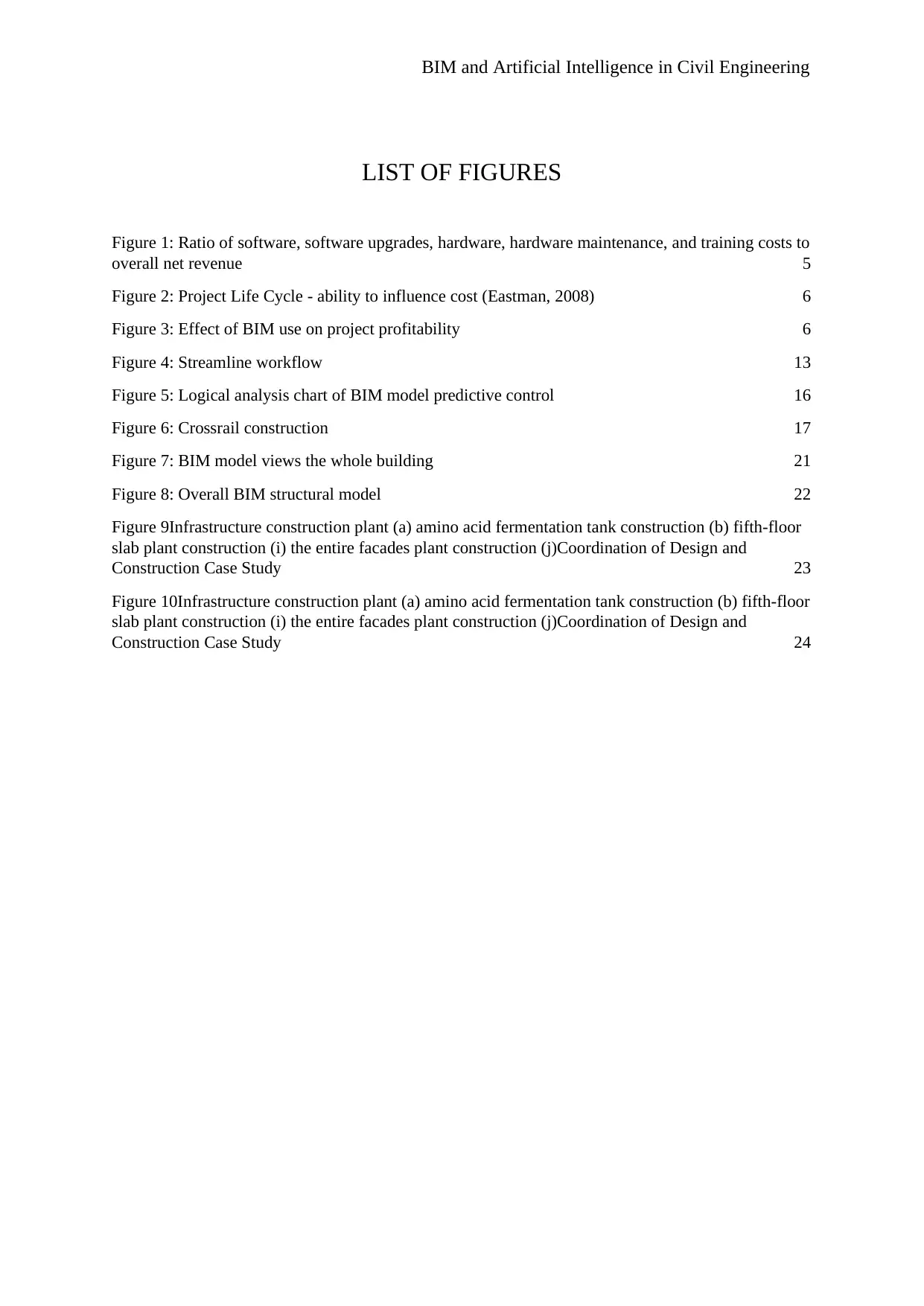
BIM and Artificial Intelligence in Civil Engineering
LIST OF FIGURES
Figure 1: Ratio of software, software upgrades, hardware, hardware maintenance, and training costs to
overall net revenue 5
Figure 2: Project Life Cycle - ability to influence cost (Eastman, 2008) 6
Figure 3: Effect of BIM use on project profitability 6
Figure 4: Streamline workflow 13
Figure 5: Logical analysis chart of BIM model predictive control 16
Figure 6: Crossrail construction 17
Figure 7: BIM model views the whole building 21
Figure 8: Overall BIM structural model 22
Figure 9Infrastructure construction plant (a) amino acid fermentation tank construction (b) fifth-floor
slab plant construction (i) the entire facades plant construction (j)Coordination of Design and
Construction Case Study 23
Figure 10Infrastructure construction plant (a) amino acid fermentation tank construction (b) fifth-floor
slab plant construction (i) the entire facades plant construction (j)Coordination of Design and
Construction Case Study 24
LIST OF FIGURES
Figure 1: Ratio of software, software upgrades, hardware, hardware maintenance, and training costs to
overall net revenue 5
Figure 2: Project Life Cycle - ability to influence cost (Eastman, 2008) 6
Figure 3: Effect of BIM use on project profitability 6
Figure 4: Streamline workflow 13
Figure 5: Logical analysis chart of BIM model predictive control 16
Figure 6: Crossrail construction 17
Figure 7: BIM model views the whole building 21
Figure 8: Overall BIM structural model 22
Figure 9Infrastructure construction plant (a) amino acid fermentation tank construction (b) fifth-floor
slab plant construction (i) the entire facades plant construction (j)Coordination of Design and
Construction Case Study 23
Figure 10Infrastructure construction plant (a) amino acid fermentation tank construction (b) fifth-floor
slab plant construction (i) the entire facades plant construction (j)Coordination of Design and
Construction Case Study 24
⊘ This is a preview!⊘
Do you want full access?
Subscribe today to unlock all pages.

Trusted by 1+ million students worldwide

BIM and Artificial Intelligence in Civil Engineering
CHAPTER 1-INTRODUCTION
Rapid advancements in technology that have been witnessed in the recent past
stimulate innovation and change in civil engineering and the construction industry in general.
The continued industrial digitization offers a good opportunity to employ new techniques for
implementing and planning a construction project in civil engineering. Building Information
Modelling (BIM) and Artificial Intelligence (AI) technologies have been seen as the main
solutions to the different challenges facing the construction sector (Tan, 2018). These
technologies have been developing and also popularly utilized in the past decades and are
mainly considered as the leading key innovative technologies recently used in civil
engineering. They have proved to be an intelligent digital building representation that plays a
critical role in supporting various activities throughout a building lifecycle. BIM is an
important architectural design process designed to meet data requirements. This requirement
is a building information model to show consistent building descriptions. As a result, BIM
can dramatically improve the design, construction and information cycle flow in various
stages. In this way they cover the life cycle of buildings, architects, equipment engineers,
contractor and owner. The use of Virtual Building BIM has created important assets space
limitations when creating projects and what are virtual construction techniques. Engineers
can help optimize the HVAC system ranking. BIM can build HVAC systems and virtual
collision detection in three dimensions environment. BIM can increase the accuracy of
estimated costs based on information provided BIM has certain depth and accuracy.
Therefore, the collection of materials and quantities consumption is relatively easy and fast.
In addition, the estimated cost increases its speed accuracy. The BIM system is used to
measure the impact of better design changes that can be used to handle household problems
automatically. Improve the accuracy of energy analysis and used to calculate power
consumption and energy production analysis of data stored in the BIM model.
The general trend in the construction industry is overcoming the BIM process.
Supervisors and construction contractors, outsource rather than Designer. Planning and
construction companies often pay for software, upgrades, hardware, maintenance and training
costs. In other words, companies cannot to send the cost of providing BIM services through
fees. They will compensate for these costs are related to their total costs. They also reduce the
number of hours needed for men drawing an image The research shown in Figure 1 shows
this as a whole costs associated with BIM technology are usually less than 2% of total net
assets income:
CHAPTER 1-INTRODUCTION
Rapid advancements in technology that have been witnessed in the recent past
stimulate innovation and change in civil engineering and the construction industry in general.
The continued industrial digitization offers a good opportunity to employ new techniques for
implementing and planning a construction project in civil engineering. Building Information
Modelling (BIM) and Artificial Intelligence (AI) technologies have been seen as the main
solutions to the different challenges facing the construction sector (Tan, 2018). These
technologies have been developing and also popularly utilized in the past decades and are
mainly considered as the leading key innovative technologies recently used in civil
engineering. They have proved to be an intelligent digital building representation that plays a
critical role in supporting various activities throughout a building lifecycle. BIM is an
important architectural design process designed to meet data requirements. This requirement
is a building information model to show consistent building descriptions. As a result, BIM
can dramatically improve the design, construction and information cycle flow in various
stages. In this way they cover the life cycle of buildings, architects, equipment engineers,
contractor and owner. The use of Virtual Building BIM has created important assets space
limitations when creating projects and what are virtual construction techniques. Engineers
can help optimize the HVAC system ranking. BIM can build HVAC systems and virtual
collision detection in three dimensions environment. BIM can increase the accuracy of
estimated costs based on information provided BIM has certain depth and accuracy.
Therefore, the collection of materials and quantities consumption is relatively easy and fast.
In addition, the estimated cost increases its speed accuracy. The BIM system is used to
measure the impact of better design changes that can be used to handle household problems
automatically. Improve the accuracy of energy analysis and used to calculate power
consumption and energy production analysis of data stored in the BIM model.
The general trend in the construction industry is overcoming the BIM process.
Supervisors and construction contractors, outsource rather than Designer. Planning and
construction companies often pay for software, upgrades, hardware, maintenance and training
costs. In other words, companies cannot to send the cost of providing BIM services through
fees. They will compensate for these costs are related to their total costs. They also reduce the
number of hours needed for men drawing an image The research shown in Figure 1 shows
this as a whole costs associated with BIM technology are usually less than 2% of total net
assets income:
Paraphrase This Document
Need a fresh take? Get an instant paraphrase of this document with our AI Paraphraser
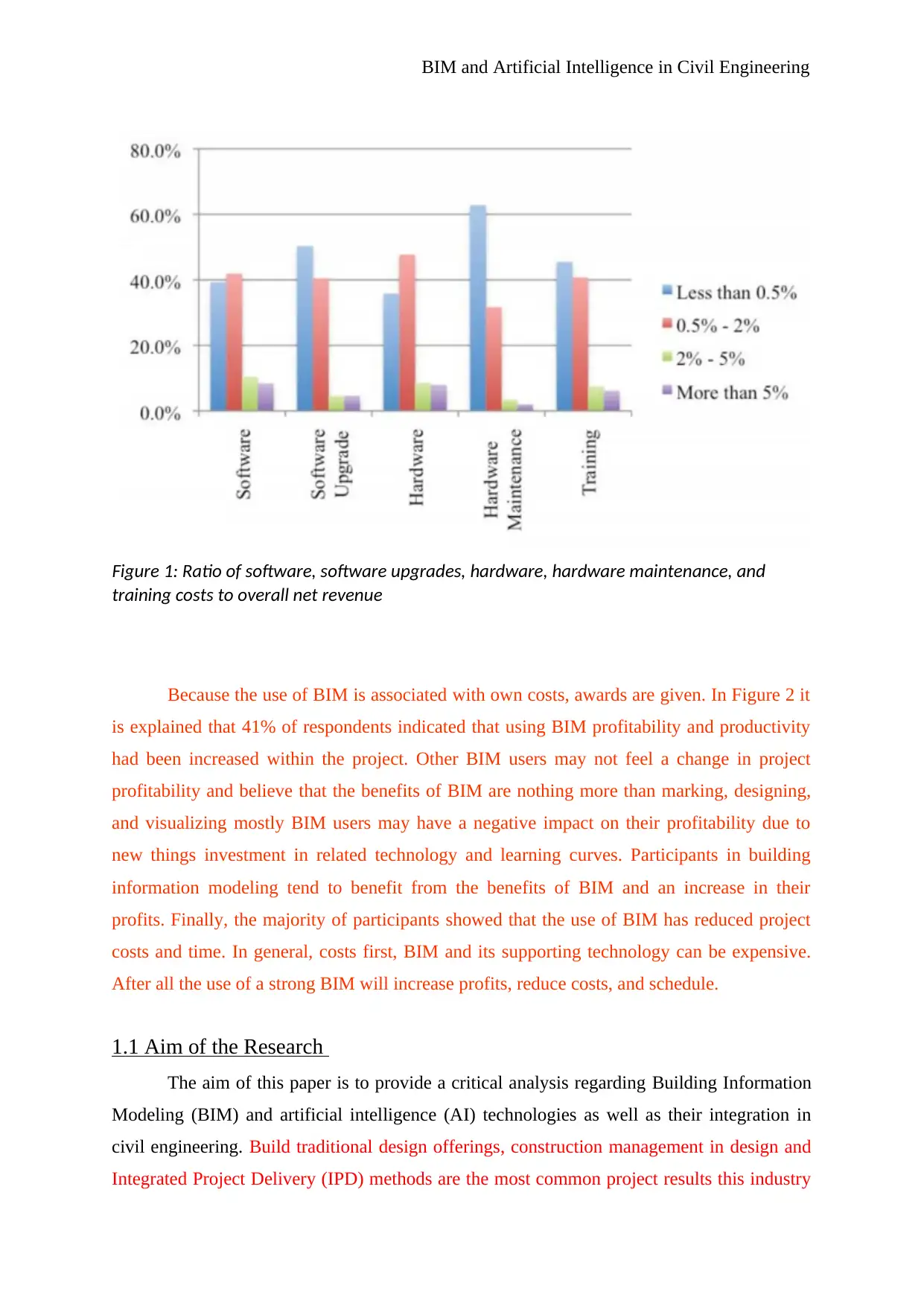
BIM and Artificial Intelligence in Civil Engineering
Because the use of BIM is associated with own costs, awards are given. In Figure 2 it
is explained that 41% of respondents indicated that using BIM profitability and productivity
had been increased within the project. Other BIM users may not feel a change in project
profitability and believe that the benefits of BIM are nothing more than marking, designing,
and visualizing mostly BIM users may have a negative impact on their profitability due to
new things investment in related technology and learning curves. Participants in building
information modeling tend to benefit from the benefits of BIM and an increase in their
profits. Finally, the majority of participants showed that the use of BIM has reduced project
costs and time. In general, costs first, BIM and its supporting technology can be expensive.
After all the use of a strong BIM will increase profits, reduce costs, and schedule.
1.1 Aim of the Research
The aim of this paper is to provide a critical analysis regarding Building Information
Modeling (BIM) and artificial intelligence (AI) technologies as well as their integration in
civil engineering. Build traditional design offerings, construction management in design and
Integrated Project Delivery (IPD) methods are the most common project results this industry
Figure 1: Ratio of software, software upgrades, hardware, hardware maintenance, and
training costs to overall net revenue
Because the use of BIM is associated with own costs, awards are given. In Figure 2 it
is explained that 41% of respondents indicated that using BIM profitability and productivity
had been increased within the project. Other BIM users may not feel a change in project
profitability and believe that the benefits of BIM are nothing more than marking, designing,
and visualizing mostly BIM users may have a negative impact on their profitability due to
new things investment in related technology and learning curves. Participants in building
information modeling tend to benefit from the benefits of BIM and an increase in their
profits. Finally, the majority of participants showed that the use of BIM has reduced project
costs and time. In general, costs first, BIM and its supporting technology can be expensive.
After all the use of a strong BIM will increase profits, reduce costs, and schedule.
1.1 Aim of the Research
The aim of this paper is to provide a critical analysis regarding Building Information
Modeling (BIM) and artificial intelligence (AI) technologies as well as their integration in
civil engineering. Build traditional design offerings, construction management in design and
Integrated Project Delivery (IPD) methods are the most common project results this industry
Figure 1: Ratio of software, software upgrades, hardware, hardware maintenance, and
training costs to overall net revenue
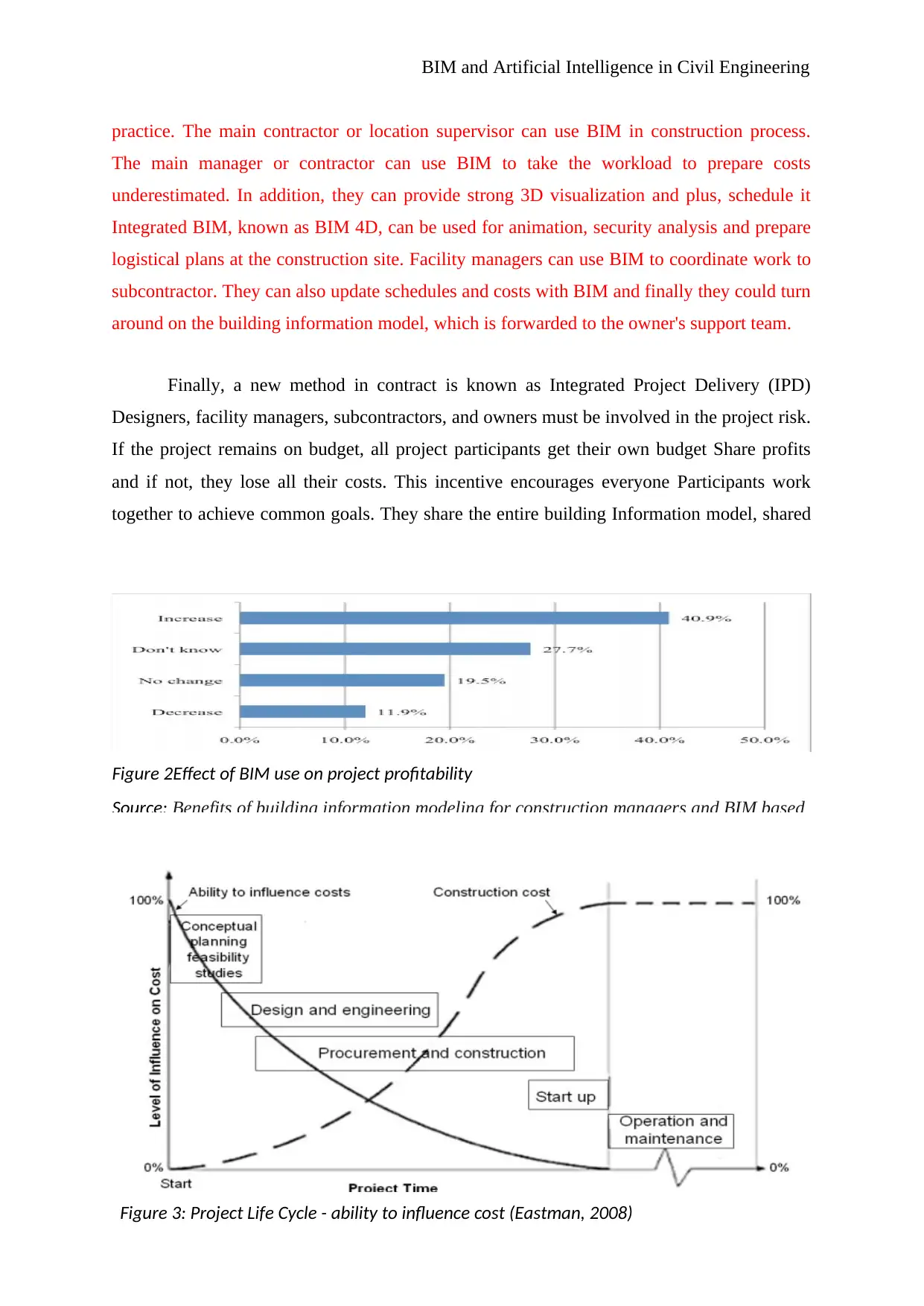
BIM and Artificial Intelligence in Civil Engineering
practice. The main contractor or location supervisor can use BIM in construction process.
The main manager or contractor can use BIM to take the workload to prepare costs
underestimated. In addition, they can provide strong 3D visualization and plus, schedule it
Integrated BIM, known as BIM 4D, can be used for animation, security analysis and prepare
logistical plans at the construction site. Facility managers can use BIM to coordinate work to
subcontractor. They can also update schedules and costs with BIM and finally they could turn
around on the building information model, which is forwarded to the owner's support team.
Finally, a new method in contract is known as Integrated Project Delivery (IPD)
Designers, facility managers, subcontractors, and owners must be involved in the project risk.
If the project remains on budget, all project participants get their own budget Share profits
and if not, they lose all their costs. This incentive encourages everyone Participants work
together to achieve common goals. They share the entire building Information model, shared
Source: Benefits of building information modeling for construction managers and BIM based
scheduling, 2019.
Figure 2Effect of BIM use on project profitability
Figure 3: Project Life Cycle - ability to influence cost (Eastman, 2008)
practice. The main contractor or location supervisor can use BIM in construction process.
The main manager or contractor can use BIM to take the workload to prepare costs
underestimated. In addition, they can provide strong 3D visualization and plus, schedule it
Integrated BIM, known as BIM 4D, can be used for animation, security analysis and prepare
logistical plans at the construction site. Facility managers can use BIM to coordinate work to
subcontractor. They can also update schedules and costs with BIM and finally they could turn
around on the building information model, which is forwarded to the owner's support team.
Finally, a new method in contract is known as Integrated Project Delivery (IPD)
Designers, facility managers, subcontractors, and owners must be involved in the project risk.
If the project remains on budget, all project participants get their own budget Share profits
and if not, they lose all their costs. This incentive encourages everyone Participants work
together to achieve common goals. They share the entire building Information model, shared
Source: Benefits of building information modeling for construction managers and BIM based
scheduling, 2019.
Figure 2Effect of BIM use on project profitability
Figure 3: Project Life Cycle - ability to influence cost (Eastman, 2008)
⊘ This is a preview!⊘
Do you want full access?
Subscribe today to unlock all pages.

Trusted by 1+ million students worldwide
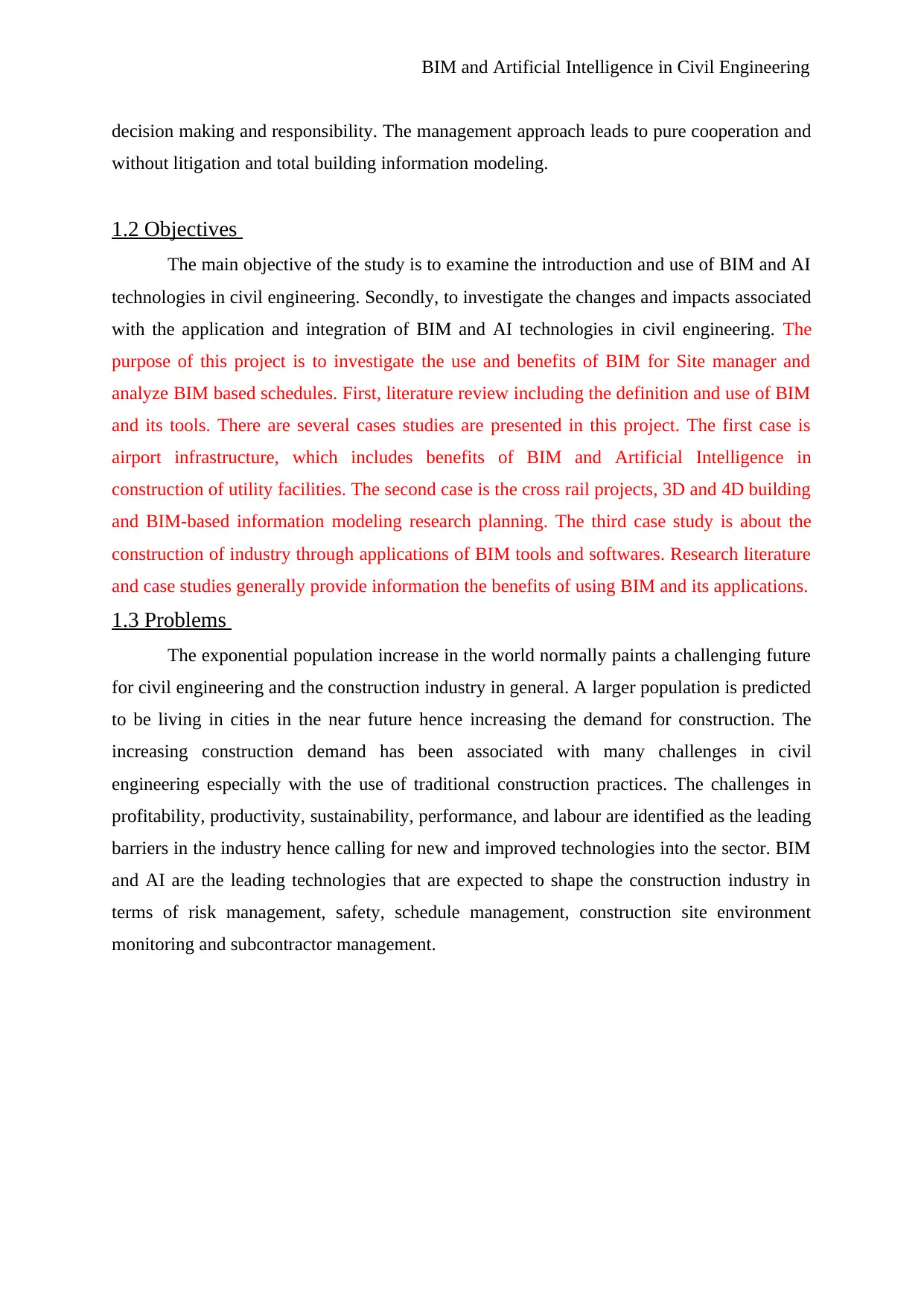
BIM and Artificial Intelligence in Civil Engineering
decision making and responsibility. The management approach leads to pure cooperation and
without litigation and total building information modeling.
1.2 Objectives
The main objective of the study is to examine the introduction and use of BIM and AI
technologies in civil engineering. Secondly, to investigate the changes and impacts associated
with the application and integration of BIM and AI technologies in civil engineering. The
purpose of this project is to investigate the use and benefits of BIM for Site manager and
analyze BIM based schedules. First, literature review including the definition and use of BIM
and its tools. There are several cases studies are presented in this project. The first case is
airport infrastructure, which includes benefits of BIM and Artificial Intelligence in
construction of utility facilities. The second case is the cross rail projects, 3D and 4D building
and BIM-based information modeling research planning. The third case study is about the
construction of industry through applications of BIM tools and softwares. Research literature
and case studies generally provide information the benefits of using BIM and its applications.
1.3 Problems
The exponential population increase in the world normally paints a challenging future
for civil engineering and the construction industry in general. A larger population is predicted
to be living in cities in the near future hence increasing the demand for construction. The
increasing construction demand has been associated with many challenges in civil
engineering especially with the use of traditional construction practices. The challenges in
profitability, productivity, sustainability, performance, and labour are identified as the leading
barriers in the industry hence calling for new and improved technologies into the sector. BIM
and AI are the leading technologies that are expected to shape the construction industry in
terms of risk management, safety, schedule management, construction site environment
monitoring and subcontractor management.
decision making and responsibility. The management approach leads to pure cooperation and
without litigation and total building information modeling.
1.2 Objectives
The main objective of the study is to examine the introduction and use of BIM and AI
technologies in civil engineering. Secondly, to investigate the changes and impacts associated
with the application and integration of BIM and AI technologies in civil engineering. The
purpose of this project is to investigate the use and benefits of BIM for Site manager and
analyze BIM based schedules. First, literature review including the definition and use of BIM
and its tools. There are several cases studies are presented in this project. The first case is
airport infrastructure, which includes benefits of BIM and Artificial Intelligence in
construction of utility facilities. The second case is the cross rail projects, 3D and 4D building
and BIM-based information modeling research planning. The third case study is about the
construction of industry through applications of BIM tools and softwares. Research literature
and case studies generally provide information the benefits of using BIM and its applications.
1.3 Problems
The exponential population increase in the world normally paints a challenging future
for civil engineering and the construction industry in general. A larger population is predicted
to be living in cities in the near future hence increasing the demand for construction. The
increasing construction demand has been associated with many challenges in civil
engineering especially with the use of traditional construction practices. The challenges in
profitability, productivity, sustainability, performance, and labour are identified as the leading
barriers in the industry hence calling for new and improved technologies into the sector. BIM
and AI are the leading technologies that are expected to shape the construction industry in
terms of risk management, safety, schedule management, construction site environment
monitoring and subcontractor management.
Paraphrase This Document
Need a fresh take? Get an instant paraphrase of this document with our AI Paraphraser
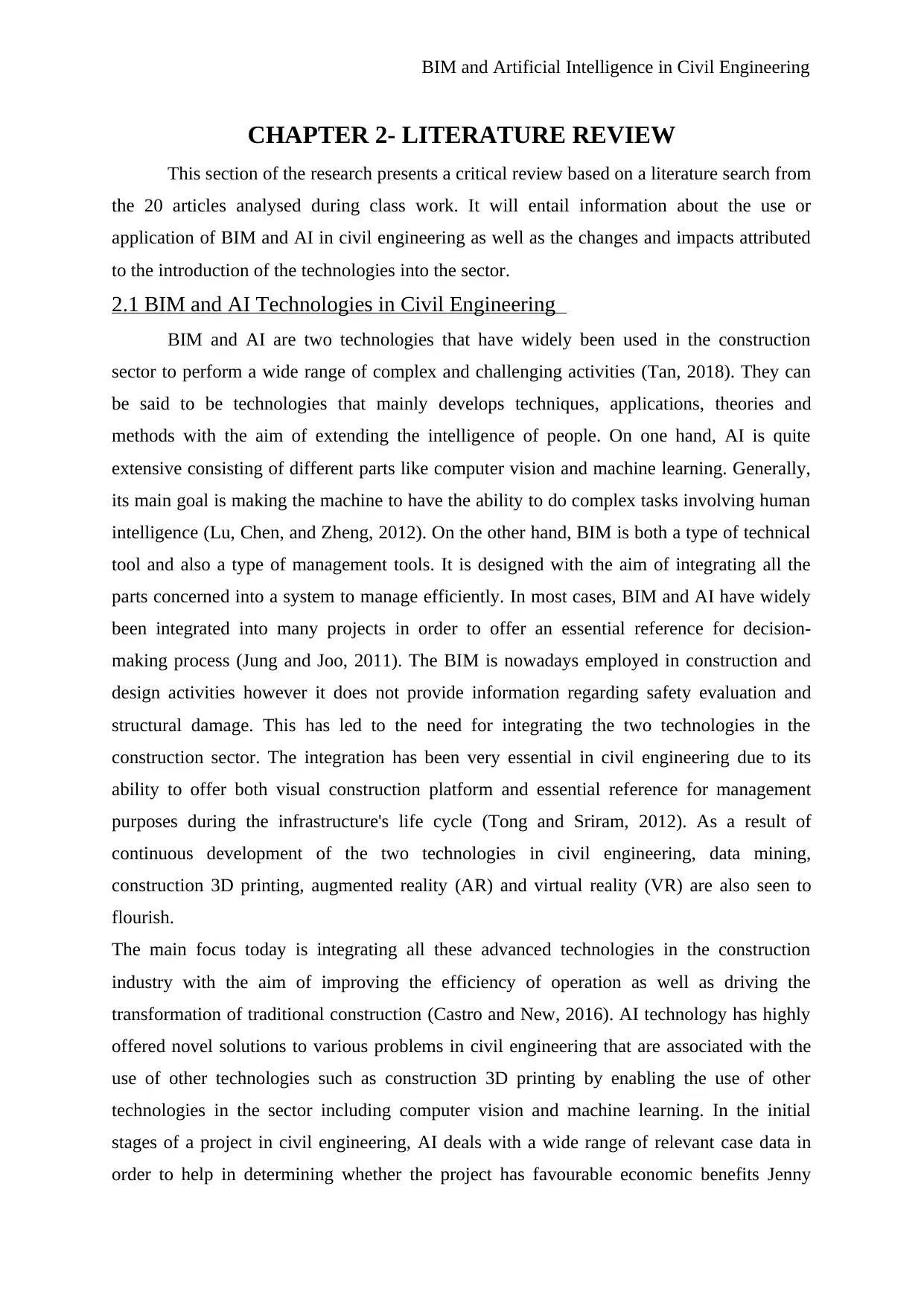
BIM and Artificial Intelligence in Civil Engineering
CHAPTER 2- LITERATURE REVIEW
This section of the research presents a critical review based on a literature search from
the 20 articles analysed during class work. It will entail information about the use or
application of BIM and AI in civil engineering as well as the changes and impacts attributed
to the introduction of the technologies into the sector.
2.1 BIM and AI Technologies in Civil Engineering
BIM and AI are two technologies that have widely been used in the construction
sector to perform a wide range of complex and challenging activities (Tan, 2018). They can
be said to be technologies that mainly develops techniques, applications, theories and
methods with the aim of extending the intelligence of people. On one hand, AI is quite
extensive consisting of different parts like computer vision and machine learning. Generally,
its main goal is making the machine to have the ability to do complex tasks involving human
intelligence (Lu, Chen, and Zheng, 2012). On the other hand, BIM is both a type of technical
tool and also a type of management tools. It is designed with the aim of integrating all the
parts concerned into a system to manage efficiently. In most cases, BIM and AI have widely
been integrated into many projects in order to offer an essential reference for decision-
making process (Jung and Joo, 2011). The BIM is nowadays employed in construction and
design activities however it does not provide information regarding safety evaluation and
structural damage. This has led to the need for integrating the two technologies in the
construction sector. The integration has been very essential in civil engineering due to its
ability to offer both visual construction platform and essential reference for management
purposes during the infrastructure's life cycle (Tong and Sriram, 2012). As a result of
continuous development of the two technologies in civil engineering, data mining,
construction 3D printing, augmented reality (AR) and virtual reality (VR) are also seen to
flourish.
The main focus today is integrating all these advanced technologies in the construction
industry with the aim of improving the efficiency of operation as well as driving the
transformation of traditional construction (Castro and New, 2016). AI technology has highly
offered novel solutions to various problems in civil engineering that are associated with the
use of other technologies such as construction 3D printing by enabling the use of other
technologies in the sector including computer vision and machine learning. In the initial
stages of a project in civil engineering, AI deals with a wide range of relevant case data in
order to help in determining whether the project has favourable economic benefits Jenny
CHAPTER 2- LITERATURE REVIEW
This section of the research presents a critical review based on a literature search from
the 20 articles analysed during class work. It will entail information about the use or
application of BIM and AI in civil engineering as well as the changes and impacts attributed
to the introduction of the technologies into the sector.
2.1 BIM and AI Technologies in Civil Engineering
BIM and AI are two technologies that have widely been used in the construction
sector to perform a wide range of complex and challenging activities (Tan, 2018). They can
be said to be technologies that mainly develops techniques, applications, theories and
methods with the aim of extending the intelligence of people. On one hand, AI is quite
extensive consisting of different parts like computer vision and machine learning. Generally,
its main goal is making the machine to have the ability to do complex tasks involving human
intelligence (Lu, Chen, and Zheng, 2012). On the other hand, BIM is both a type of technical
tool and also a type of management tools. It is designed with the aim of integrating all the
parts concerned into a system to manage efficiently. In most cases, BIM and AI have widely
been integrated into many projects in order to offer an essential reference for decision-
making process (Jung and Joo, 2011). The BIM is nowadays employed in construction and
design activities however it does not provide information regarding safety evaluation and
structural damage. This has led to the need for integrating the two technologies in the
construction sector. The integration has been very essential in civil engineering due to its
ability to offer both visual construction platform and essential reference for management
purposes during the infrastructure's life cycle (Tong and Sriram, 2012). As a result of
continuous development of the two technologies in civil engineering, data mining,
construction 3D printing, augmented reality (AR) and virtual reality (VR) are also seen to
flourish.
The main focus today is integrating all these advanced technologies in the construction
industry with the aim of improving the efficiency of operation as well as driving the
transformation of traditional construction (Castro and New, 2016). AI technology has highly
offered novel solutions to various problems in civil engineering that are associated with the
use of other technologies such as construction 3D printing by enabling the use of other
technologies in the sector including computer vision and machine learning. In the initial
stages of a project in civil engineering, AI deals with a wide range of relevant case data in
order to help in determining whether the project has favourable economic benefits Jenny
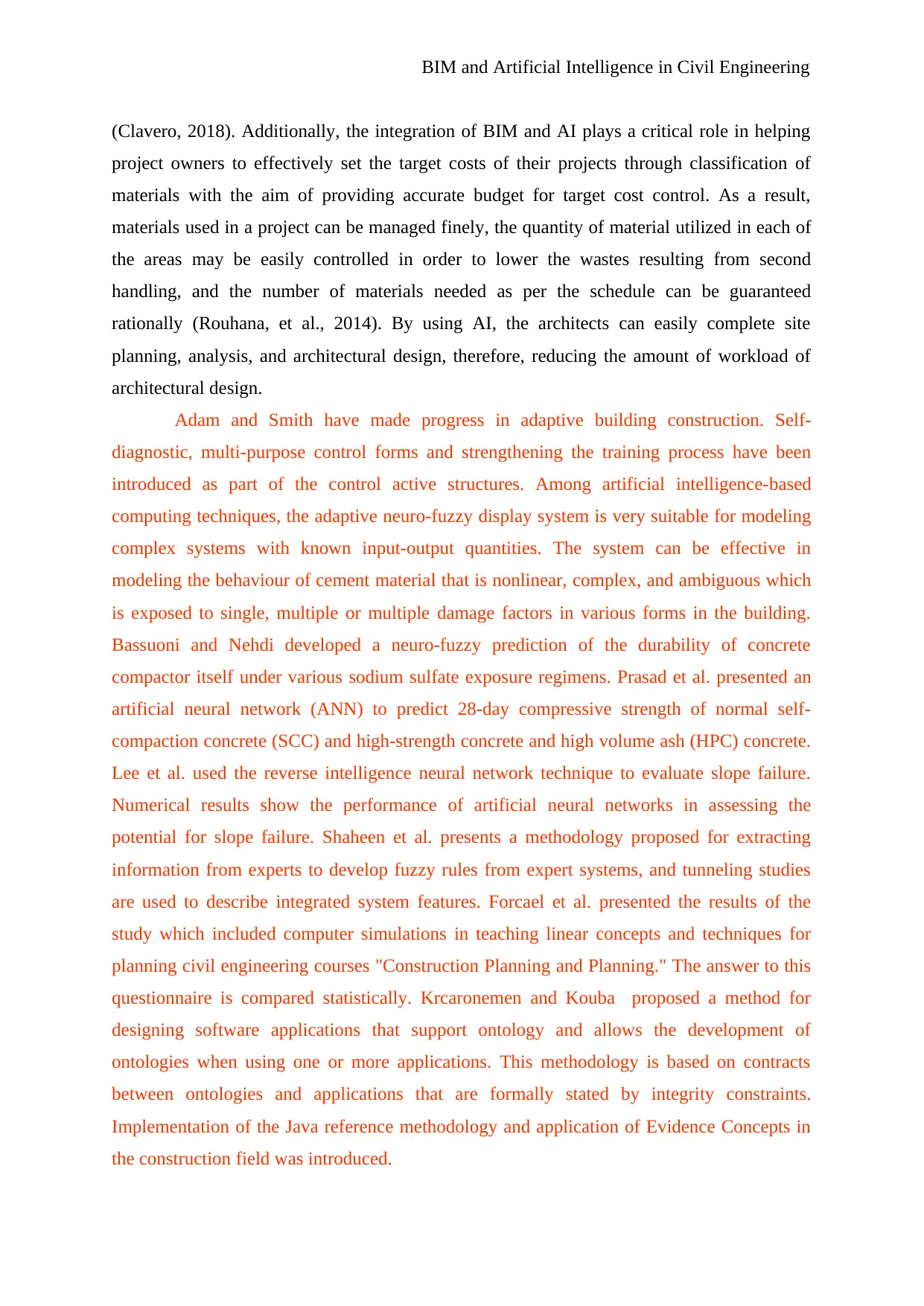
BIM and Artificial Intelligence in Civil Engineering
(Clavero, 2018). Additionally, the integration of BIM and AI plays a critical role in helping
project owners to effectively set the target costs of their projects through classification of
materials with the aim of providing accurate budget for target cost control. As a result,
materials used in a project can be managed finely, the quantity of material utilized in each of
the areas may be easily controlled in order to lower the wastes resulting from second
handling, and the number of materials needed as per the schedule can be guaranteed
rationally (Rouhana, et al., 2014). By using AI, the architects can easily complete site
planning, analysis, and architectural design, therefore, reducing the amount of workload of
architectural design.
Adam and Smith have made progress in adaptive building construction. Self-
diagnostic, multi-purpose control forms and strengthening the training process have been
introduced as part of the control active structures. Among artificial intelligence-based
computing techniques, the adaptive neuro-fuzzy display system is very suitable for modeling
complex systems with known input-output quantities. The system can be effective in
modeling the behaviour of cement material that is nonlinear, complex, and ambiguous which
is exposed to single, multiple or multiple damage factors in various forms in the building.
Bassuoni and Nehdi developed a neuro-fuzzy prediction of the durability of concrete
compactor itself under various sodium sulfate exposure regimens. Prasad et al. presented an
artificial neural network (ANN) to predict 28-day compressive strength of normal self-
compaction concrete (SCC) and high-strength concrete and high volume ash (HPC) concrete.
Lee et al. used the reverse intelligence neural network technique to evaluate slope failure.
Numerical results show the performance of artificial neural networks in assessing the
potential for slope failure. Shaheen et al. presents a methodology proposed for extracting
information from experts to develop fuzzy rules from expert systems, and tunneling studies
are used to describe integrated system features. Forcael et al. presented the results of the
study which included computer simulations in teaching linear concepts and techniques for
planning civil engineering courses "Construction Planning and Planning." The answer to this
questionnaire is compared statistically. Krcaronemen and Kouba proposed a method for
designing software applications that support ontology and allows the development of
ontologies when using one or more applications. This methodology is based on contracts
between ontologies and applications that are formally stated by integrity constraints.
Implementation of the Java reference methodology and application of Evidence Concepts in
the construction field was introduced.
(Clavero, 2018). Additionally, the integration of BIM and AI plays a critical role in helping
project owners to effectively set the target costs of their projects through classification of
materials with the aim of providing accurate budget for target cost control. As a result,
materials used in a project can be managed finely, the quantity of material utilized in each of
the areas may be easily controlled in order to lower the wastes resulting from second
handling, and the number of materials needed as per the schedule can be guaranteed
rationally (Rouhana, et al., 2014). By using AI, the architects can easily complete site
planning, analysis, and architectural design, therefore, reducing the amount of workload of
architectural design.
Adam and Smith have made progress in adaptive building construction. Self-
diagnostic, multi-purpose control forms and strengthening the training process have been
introduced as part of the control active structures. Among artificial intelligence-based
computing techniques, the adaptive neuro-fuzzy display system is very suitable for modeling
complex systems with known input-output quantities. The system can be effective in
modeling the behaviour of cement material that is nonlinear, complex, and ambiguous which
is exposed to single, multiple or multiple damage factors in various forms in the building.
Bassuoni and Nehdi developed a neuro-fuzzy prediction of the durability of concrete
compactor itself under various sodium sulfate exposure regimens. Prasad et al. presented an
artificial neural network (ANN) to predict 28-day compressive strength of normal self-
compaction concrete (SCC) and high-strength concrete and high volume ash (HPC) concrete.
Lee et al. used the reverse intelligence neural network technique to evaluate slope failure.
Numerical results show the performance of artificial neural networks in assessing the
potential for slope failure. Shaheen et al. presents a methodology proposed for extracting
information from experts to develop fuzzy rules from expert systems, and tunneling studies
are used to describe integrated system features. Forcael et al. presented the results of the
study which included computer simulations in teaching linear concepts and techniques for
planning civil engineering courses "Construction Planning and Planning." The answer to this
questionnaire is compared statistically. Krcaronemen and Kouba proposed a method for
designing software applications that support ontology and allows the development of
ontologies when using one or more applications. This methodology is based on contracts
between ontologies and applications that are formally stated by integrity constraints.
Implementation of the Java reference methodology and application of Evidence Concepts in
the construction field was introduced.
⊘ This is a preview!⊘
Do you want full access?
Subscribe today to unlock all pages.

Trusted by 1+ million students worldwide
1 out of 43
Related Documents
Your All-in-One AI-Powered Toolkit for Academic Success.
+13062052269
info@desklib.com
Available 24*7 on WhatsApp / Email
![[object Object]](/_next/static/media/star-bottom.7253800d.svg)
Unlock your academic potential
Copyright © 2020–2025 A2Z Services. All Rights Reserved. Developed and managed by ZUCOL.





